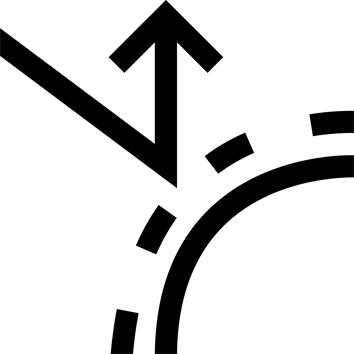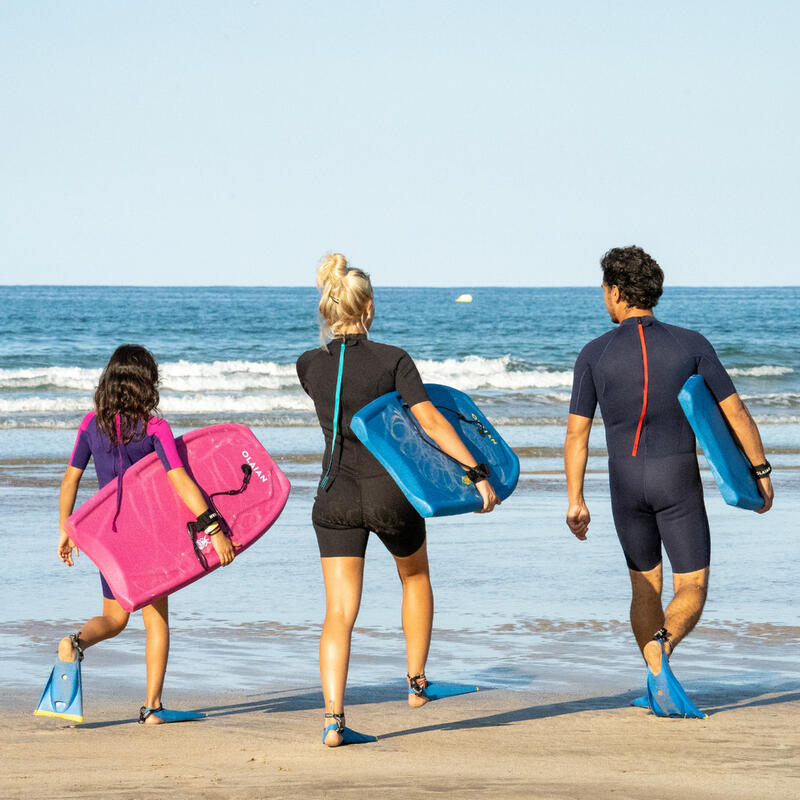Intuitive and educational
To help you catch more waves, we work to make our products as intuitive and educational as possible.
That's why this bodyboard has an ergonomic deck that will help you spontaneously get into the right position.
Indications of the user's height and wave size are specified on the board.
A QR code on the underside will give you access to tutorials and other useful information: maintenance, 2nd life...
Size guide / How to choose your bodyboard size?
The size of the bodyboard has a direct influence on its stability and handling. It must be adapted to the user's size.
This bodyboard 100 is available in 3 sizes depending on the user's size:
Size 36" if you are between 1m25 and 1m45
Size 39" if you are between 1m45 and 1m65
Size 42" if you are between 1m65 and 1m85
A bodyboard that is too small will not float enough and will therefore make you miss the waves.
A bodyboard that is too big will be more difficult to handle.
We design bodyboard products according to 4 levels of practice: Discoverer, Beginner, Advanced and Expert.
- Découvreur : Eau jusqu'au nombril, pas de palme, mousses <50cm, propulsion en poussant les pieds sur le sol, prise de vague jusqu'au bord. Priorité au plaisir et 1ères sensations (Bodyboard à poignées).
- Débutant : Légers virages dans des vagues <1m, propulsion avec palmes. Priorité à l'apprentissage du sport.
- Confirmé : Vagues jusqu'à 1m50, plus de vitesse et début de figures (360°, El Rollo...).
- Expert : Tout type de vagues, maîtrise des figures, même aériennes (ARS, 360°, tube...).
Construction adapted to the size and conditions of intended use: Beginner level.
This 100 bodyboard has been designed for use in waves of up to 1m.
It has been tested and validated in these conditions, by real beginners as well as confirmed and expert riders.
If used in waves over 1m, it may deteriorate: breakage, bending... In this case, prefer bodyboards 500 or 900. In this case, prefer bodyboards 500 or 900.
The plastic-coated underside of this bodyboard makes it easier to glide and more durable.
Wear other than breakage can be repaired, but check online or in store.
Did you know? Using fins allows you to catch 2 to 3 times more waves!
In the ocean, when the water is deeper than the navel, it's very complicated to catch waves without the help of fins.
In fact, it's no longer possible to propel yourself by pushing your feet off the ground to get momentum in the wave, and paddling with your arms is often insufficient.
For a discovery of bodyboarding in good conditions, for optimal progress and increased safety against the currents of our coasts, we strongly recommend the use of bodyboard fins.
Correct positioning on the bodyboard guarantees a good glide through the wave.
Nose bumpers provide a good grip for your hands.
When catching a wave, your hands are in front, chest arched, to maximize buoyancy and the power produced by your feet (webbed, of course!).)
To go left, keep your left hand in front (hand/elbow/shoulder aligned, arm bent at 90°) and put your right hand on the right rail at hip level.
Keep your left leg alongside the board to hold your direction.
Inversely to go right.
Tips to avoid chafing and ensure good adhesion to the board.
On the wave, the bodyboard is best used lying down.
It's important to wear a long-sleeved anti-UV top or a wetsuit, depending on the water temperature, to avoid (painful) irritations on the stomach and arms.
For a good grip on the bodyboard, it's recommended to wax it on the front of the board, on the sides (rails) and on the stomach. Wax to be adapted to temperature, sold separately in the surf department.
Repeat the operation every session.
Safety rules and behaviour in the water - Part 1.
Bodyboarding is a fantastic sport that requires certain fundamental rules to be respected for everyone's enjoyment and safety.
1- Find out about and observe the characteristics of the spot: current, rocks, tidal influence, wave size, number of people in the water...
2- Don't overestimate your level and prefer an easier spot if conditions exceed your abilities.
3- Use the right equipment: leash, fins and board in good condition, suitable neoprene wetsuit.
Safety rules and behavior in the water - Part 2.
4- Respect the rules of priority on the wave: priority to whoever is closest to the breaker.
5- Go around the breaker zone when you go up to the peak to avoid cutting the path of another rider.
6- Use flippers if the water level is higher than your hips.
7- If you don't use flippers, we recommend that you practice in the safe swimming area. Ask the lifeguards on site for more information.
8- Practice with others.
Do not expose the bodyboard to extreme heat.
When not in use, take care not to expose your bodyboard to the sun or to temperatures >50°C.
Protect your bodyboard in a cover, under an umbrella, in the shade or under a light towel, to prevent it from overheating.
Avoid leaving it in a car in direct sunlight.
The consequence of exposure to excessive heat can be blisters or bubbles forming on the board, or even deformation of the board.
Tips for repairing your board
Despite all the care taken in the design of our products, it can happen that the foam comes unstuck or that you have made a hole in it. In this video, you'll find all the information you need to repair these little defects and extend its life. https://www.youtube.com/watch?v=DFTUqJ6P7UE
Dimensions
36": 92cm x 47.4cm x 5.7cm
39": 100cm x 50.9cm x 5.7cm
42": 107cm x 54.5cm x 5.7cm




